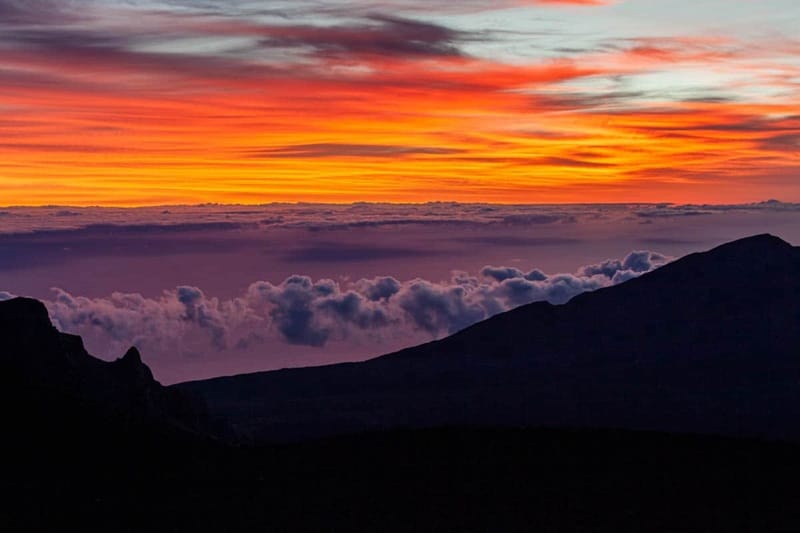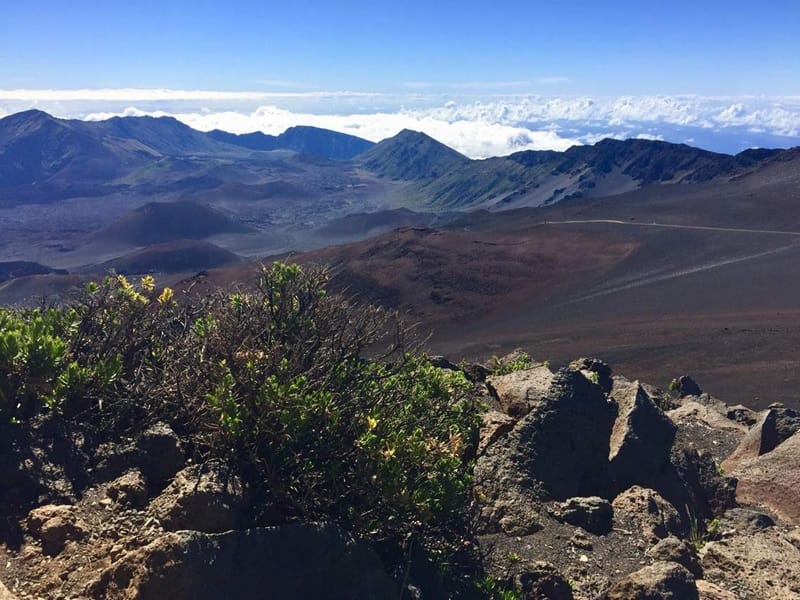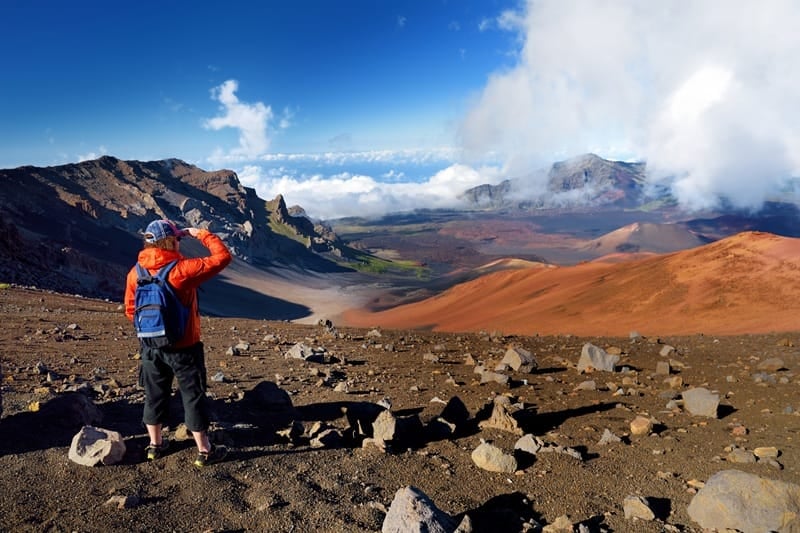On the island of Maui, Haleakala National Park—often called the house of the sun—is tied to the legend of the demigod Maui. From the volcanic summit to lush rainforest, it’s a place of big views, big skies, and quiet moments you’ll never forget.
In this guide, we’ll cover everything you need to know—fees, permits, weather, best hikes, and local tips—so you can plan your visit with confidence. Let’s get started!
At a Glance
- Where: East Maui has two districts—Summit (10,023 ft elevation) and Kipahulu (near Hana). Both are open 24 hours, but you’ll need a Haleakala sunrise reservation if entering the Summit between 3:00 and 7:00 a.m.
- Elevation: The Haleakala summit rises 10,023 ft above sea level. It’s one of the highest points in Hawaii, with breathtaking views and thinner air—so take it slow and stay hydrated.
- Fees:
- Private vehicle – $30 (valid 3 days)
- Per person (no car) – $15
- Motorcycle – $25
- Sunrise reservation – $1 per vehicle (separate from entry fee)
- The park is cashless, so bring a card or purchase your pass online ahead of time.
- Services: There’s no food, gas, or EV charging inside the park. Fill up your tank and pack snacks before you go.
- Current Conditions: Always check the National Park Service Alerts & Conditions before your trip for weather or closures. Swimming at the Pools of Oheo is no longer allowed—view them from the Kuloa Point Trail instead.

Photo courtesy of Travel Hawaii With Us
The Two Districts of Haleakala
1) Summit District
Standing at over 10,000 feet, the Summit District feels like another planet. The summit area sits at a high altitude, so the air feels like thin air compared to the coast. Up here you can peer into the colorful cinder cones of the Haleakalā crater and stand on the summit of Haleakala (also written the summit of Haleakalā) for a horizon that seems to go on forever.
- Pa Kaoao (White Hill): A 0.4-mile round trip with amazing panoramic views.
- Sliding Sands Trail (Keoneheehee): Try the first half-mile for a quick crater experience.
- Halemauu Trail: A 1.1-mile hike to the “Rainbow Bridge” viewpoint for unforgettable crater views.
Kahului – ~2.5 hrs • Wailea – ~3 hrs • Lahaina – ~3.5 hrs
There’s no public transportation, so plan ahead and leave early.
Weather & Altitude
At 10,000 feet, the air is thinner and the weather cooler—often 30°F colder than the coast. Expect highs around 50–65°F, with strong winds and fast-changing clouds. Bring layers and watch for altitude sickness (headache, nausea, dizziness).
2) Kipahulu District (Coastal Rainforest near Hana)
This lush area sits about 12 miles past Hana and is full of waterfalls, bamboo forests, and ocean views. Kipahulu protects native habitats and endangered species—please stay on trail, pack out your trash, and leave plants and rocks undisturbed.
Must-do hikes:
- Pipiwai Trail to Waimoku Falls: 4 miles round trip through banyan trees and bamboo groves to a stunning 400-foot waterfall.
- Kuloa Point Trail: A short, scenic loop with ocean views and a look at the Pools of Oheo (no swimming).

Photo courtesy of MyHikes
Haleakala Sunrise (How to Get a Spot)
Watching the sunrise at Haleakala is one of the most popular things to do on Maui. To enter between 3:00 and 7:00 a.m., you’ll need a reservation.
Arrive early to find a spot and follow the ranger’s directions in the parking lot. If you prefer not to drive, some Maui tour operators offer sunrise transport or guided experiences that handle logistics while you focus on the view.
- Where to book: Recreation.gov
- When: Up to 60 days in advance (a few spots release 48 hours before).
- Cost: $1 per vehicle (plus park entry fee).
- Visitor centers usually open after sunrise, so come prepared with food, water, and layers.
Pro tip: Can’t get a sunrise permit? Go for Haleakala sunset instead—it’s just as colorful and doesn’t need a reservation. Stick around for stargazing Haleakala once the sky goes dark!
Stargazing & the Night Sky
With minimal light pollution and clear skies, Haleakala is one of the best places in Hawaii for stargazing. Bring a blanket and a flashlight with a red filter to protect your night vision.
Note: The Haleakala Observatories (“Science City”) are off-limits to visitors but can be admired from afar.
Camping, Cabins & Overnight Options
Want to stay under the stars? Haleakala offers a few great camping options:
- Hosmer Grove Campground (Summit): Cool, alpine setting with picnic tables and restrooms.
- Kipahulu Campground (Coastal): Near ocean views and rainforest trails.
Both require reservations on Recreation.gov ($20/night, up to 3 nights). For hikers, Holua, Paliku, and Kapalaoa cabins require wilderness permits and are only reachable by trail.
Note: Sleeping in your car is not allowed inside the park.
| Type | Cost | Notes |
|---|---|---|
| Private Vehicle | $30 | Valid for 3 days, both districts |
| Motorcycle | $25 | Same access as vehicle |
| Per Person (no car) | $15 | Walk-in or bicycle |
| Sunrise Reservation | $1 | Required for 3–7 a.m. Summit entry |
Getting There & What to Know
- Last gas for the Summit: Pukalani. For Kipahulu: Paia. No gas or food inside the park.
- Drive slowly: Roads are steep and winding. Watch for nene (Hawaiian geese).
- EVs: Fully charged vehicles may still struggle with the elevation—plan accordingly.
Safety, Etiquette & Cultural Respect
Haleakala is a sacred site to Native Hawaiians, so visit with care and respect.
✅ Stay on trails and keep voices low.
✅ Don’t touch rocks, plants, or cultural features.
✅ Admire the Hawaiian silversword plant from a distance—it’s fragile and rare.
✅ Pack layers, food, and water, and take breaks if you feel light-headed.

Photo Courtesy of Hawaii Aloha Travel
Suggested Itineraries
A) Sunrise + Summit Sampler (½ Day)
- 3:00–7:00 a.m.: Watch sunrise from Puu Ulaula (Red Hill) or the Haleakala Visitor Center overlook.
- Take short walks on Pa Kaoao and Sliding Sands Trail.
- Stop in Kula for breakfast on your way down.
B) Full Summit Adventure (Full Day)
- Add Halemauu Trail or a longer Sliding Sands segment.
- Pack for cold temps, wind, and sun.
C) Kipahulu Highlights (Full Day)
- Drive the Hana Highway.
- Hike the Pipiwai Trail to Waimoku Falls.
- End with the Kuloa Point Trail for ocean views.
- Swimming at Oheo is closed, but the scenery is unbeatable.
Make It a Sunrise + Snorkel Day 🌅🐠
After sunrise at Haleakala, trade the mountain air for Maui’s clear ocean water! It’s easy to pair your early-morning adventure with a snorkeling tour—you’ll be back near the coast just in time for lunch.
Maui Snorkeling Tours:
Molokini Crater Snorkeling Tour: 7 AM–12 PM — all-inclusive with breakfast, lunch, snorkeling gear, and a fun waterslide!
Afternoon Snorkeling Tour: 1 PM–4 PM — includes lunch and gear, perfect for families.
Book your tour:
👉 Molokini Crater Snorkeling Tour
Accessibility
Haleakala Visitor Centers, restrooms, and Hosmer Grove picnic areas are wheelchair accessible. However, most summit trails are not, and the Kipahulu trails can be steep or muddy beyond paved areas.
FAQs About Haleakala National Park
Do I need a reservation for Haleakala?
Only for sunrise vehicle entry between 3–7 a.m. Daytime visits just need a regular park pass.
Can I swim in the Seven Sacred Pools?
No. Swimming is not allowed, but you can admire them from the Kuloa Point Trail.
How cold does it get at the top?
It’s usually 30°F colder than the coast—bundle up!
How long is the drive to the summit?
About 2.5 hours from Kahului, 3 from Wailea, and 3.5 from Lahaina.
Are there services at the top?
No food, gas, or charging—come prepared.

Final Thoughts
🌺 Visiting Haleakala National Park is a spiritual and scenic experience that shows the heart of Maui. You’ll witness the power of nature, feel the island’s peaceful energy, and see why locals and visitors alike hold this place dear.
So pack your layers, book that sunrise spot, and don’t forget your camera. And when you’re done exploring the clouds, join Maui Snorkeling for a relaxing afternoon on the water. From the top of the volcano to the reefs below the sea—it’s the perfect way to experience all that Maui has to offer. 🌄🌊

